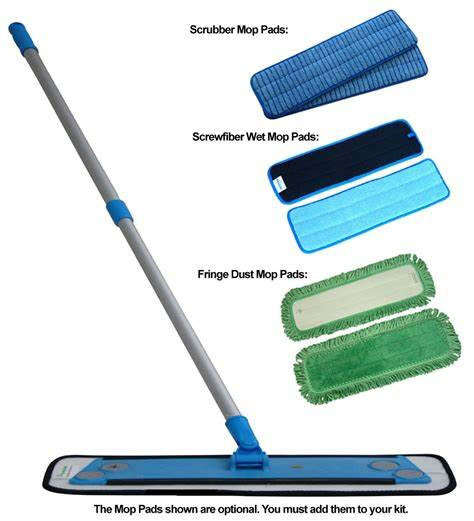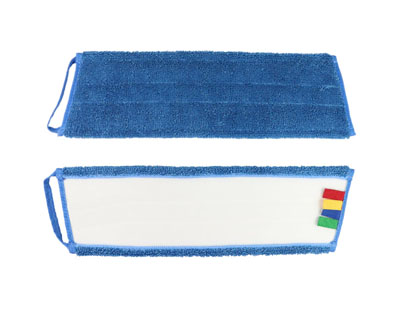Choose the Perfect Floor Mop
Some spills on hard floors simply can't be handled with a vacuum or broom. Learn about the different types of mops and the types of jobs they are best suited for.
Choosing the perfect floor mop
Mops are often needed to remove sticky or dry stains. Even if you're not dealing with a big mess on your hard floors, regular mopping will keep them in top shape. The best floor mop for you depends on many factors, including how often you mop, the type of floors you need to clean, and your comfort level with cleaning chemicals.
Wet Mops and Spin Mops
Wet mops and rotary mops are the traditional tools that probably come to mind first when you hear the word "mop". A wet mop uses a liquid (usually water or floor cleaner) to absorb any residual dirt that a dry mop, vacuum cleaner or broom can't remove.
The head of a wet mop, the part that actually gets wet and comes into contact with the floor, can come in a variety of styles or materials. Non-wringing mops are classic mops with a head usually made of cotton or microfiber rope or strips. Spin mops have the same type of head as non-wringing mops, but they are made with a ratchet mechanism that allows you to spin the head and wring out excess water and dirt.
Spin mops have a round microfiber head similar to many wet mops. They come with a mop bucket that has a built-in rotating basket to remove water and dirt from the mop head. The basket is usually operated by a foot pedal or handle mechanism. Most rotating mop buckets are divided into a clear water section and a dirty water section, with the dirty water section located below the rotating basket to collect debris.
There are two main varieties of sponge mops: the butterfly mop or the rolling mop. The main difference between the two is the mechanism they use to wring out the sponge head. The butterfly mechanism folds the sponge in half to squeeze out water and dirt, while the rolling mechanism rolls over the sponge to perform the same operation.
Wet mops are best for cleaning up large messes and keeping hard floors shiny. Spin mops, especially rope mops, are great for cleaning up hair or large debris. The fibers of these mops will trap hair and large debris, while a flat sponge or mop may simply push it to another location.
Additional resources:
What is wrinkle free cotton?
Ultimate Mop Material Price List: Your Guide
Everything You Need To Know To Find The Best silver antimicrobial fabrics
Is coral fleece better than microfiber?
Which Microfiber Material for Sale Shines Brightest for Clean Freaks?
Which is the best suede microfiber cloth for a flawless purchase experience?
Can you revive microfiber towels?
Since you're using a wet mop to absorb dirt, you'll need to clean the head after each use. Many mops have removable heads, making them easier to clean. Some fine rope or microfiber mop heads are even machine washable. Conventional mop heads should be replaced every two to three months, as the fibers break down and begin to clean less efficiently, while also trapping more bacteria. Sponge heads may need to be replaced more frequently, as they cannot be put in the washing machine.
Stick mops and dust mops
Stick mops and dust mops, also known as dry mops, are popular for their ease of use and ease of cleaning. Dust mops have a flat end at the end of the bar to which you can attach a disposable or reusable pad. Reusable pads are usually made of microfiber, but cotton tips can also be used. Disposable pads come in dry versions or pre-moistened versions soaked in a cleaning solution; reusable tampons can usually be used both wet and dry. When you push the mop onto the floor, the pads attract dirt and dust and can then be discarded or put in the washing machine for cleaning.

Stick mops don't require a bucket or water, so you have less work to do. Once soiled, a traditional wet mop may still spread some dirt or bacteria even after being wrung out, which is not a problem with a stick mop. The convenience of this option also includes the availability of disposable or machine-washable sanitary napkins. Reusable pads are often more durable than traditional wet mop heads - sometimes they can be washed up to 50 times - and don't need to be replaced as often. This is a great option if you find yourself needing to mop more often.
Spray mop
The Spray Mop is an upgraded version of the Stick Mop with a water tank or a housing that allows you to attach a bottle of cleaning solution. The flat head has nozzles on the front, and when you press the trigger or button on the mop handle, the liquid from the tank or bottle sprays onto your floor. You can then push the mop head with the disposable or reusable pad into the solution to wet it and clean your floor. Just like their stick mop cousins, spray mops are convenient and clean up is easy. Since it's the spray solution that wets them, all the pads used on these mops will dry out.
Whether it's a store-bought bottle or a homemade solution, you can use any cleaning solution you like with a spray mop. Whatever you choose, make sure it's safe to use on your floors. For example, hardwood floors require a specific cleaning solution and should not be cleaned with soaps and detergents. Some mop brands only accept specific spray bottles, so check for compatibility before you buy. You also want to make sure that the solution you choose is safe for all children and pets in your home.
Which CVC Cotton 240 GSM Blend is Best for Sustainable Fashion?
Are scouring pads better than sponges?
Uncover the Secret to Vibrant Yellow Cotton Fabric: Tips, Tricks & Care
Is bamboo fabric expensive?
What is CVC material?
Unveiling the Ultimate Guide to Cloth Fabric
The Ultimate Guide to Custom Microfiber Cloths


Comments
0